This page will provide information on how to raise pigs in a pigsty in Farming Simulator 22.
In this guide, you will learn about the different types of pigsties available, the various types of pigs, feeding requirements, reproduction, and how to collect manure and slurry. Additionally, we’ll cover how profitable pig breeding can be.
One of the most significant ways to make money in Farming Simulator 22 is by selling adult pigs for their meat. Pigs grow quickly and are highly reproductive. The rate of growth is determined by the quality of their feed; the better the feed, the faster they will grow. Pigs also produce a substantial amount of natural manure – slurry (liquid) and manure (solid form, which requires straw to be delivered to the pigsty). This can save you a lot of money on fertilizers.
- Types of Farm Houses
- Types of Pigs
- Feeding
- Reproduction
- Slurry and Manure
- Profitability
Types of Farm Houses
- Pasture: 30 pigs, feeding capacity – 9,500l (requires water supply), water capacity: 3,000l, price: 28,000 EUR
- Pigsty: 108 pigs, food capacity – 34,000l, straw – 15,000l, price: 109,000 EUR
- Large Pigsty: 270 pigs, food capacity – 85,000l, straw – 45,000l, price: 164,000 EUR
Investing in a pigsty is a wise decision, as pig breeding’s profitability is directly linked to the number of pigs you have. Pigs breed very quickly, and you can feed them almost anything. Even if you don’t pay close attention to breeding, the investment will quickly pay for itself. Pastures do not generate manure or slurry.
Types of Pigs
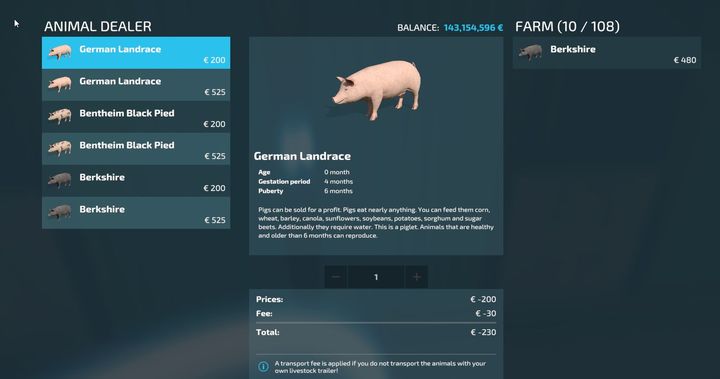
There are three pig species, which differ only in appearance. However, there is a notable difference in age: you can purchase young, inexpensive pigs (200 EUR) or adult pigs (416 EUR) at six months old. If you buy adult pigs, they will immediately begin to reproduce under optimal conditions.
Feeding
If you want your pigs to be as productive as possible (i.e., reproduction, fertilizer production, and value – all dependent on their health), you must provide them with the best possible food or a mix of different foods.
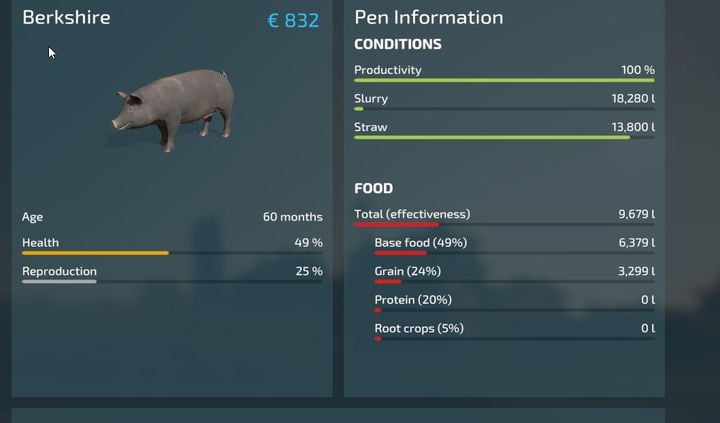
Pigs eat the following plants, divided into four groups, each with a different efficiency:
- Base food (maize/sorghum) – 50% efficiency
- Grains (wheat/barley) – 25% efficiency
- Proteins (soybeans/canola/sunflower) – 20% efficiency
- Root crops (potatoes/beets) – 5% efficiency
In reality, pigs require basic food and at least one of the other categories of plants. You must grow corn or sorghum and, for example, barley (due to the large harvest per hectare).
The consumption of a given type of food is proportional to the indicated efficiency: if a pig eats 50l of corn, then it will only need 25l of wheat and 5L of potatoes. The problem may be the dosage of food, also because it is possible to fill the entire warehouse with one type of plant, so you will not be able to add more products.

If you want to maximize productivity with fewer crops, you can buy Pig food from the store (available in pallets and bags) [not to be confused with Mineral feed]. It provides 100% animal production, but it is expensive and affects your profit from pigs. Pig feed is available in large bags of 1,000l, but it takes a long time to load onto the trailer. To make transportation easier, you can pour it into a trailer.
You cannot place the feed pallet in the feeding area. If you do not load the pallet onto the trailer, you have to hold it in the air, and the feed will start pouring out of the hole at the bottom.

To feed the pigs, drop the food into the silo.
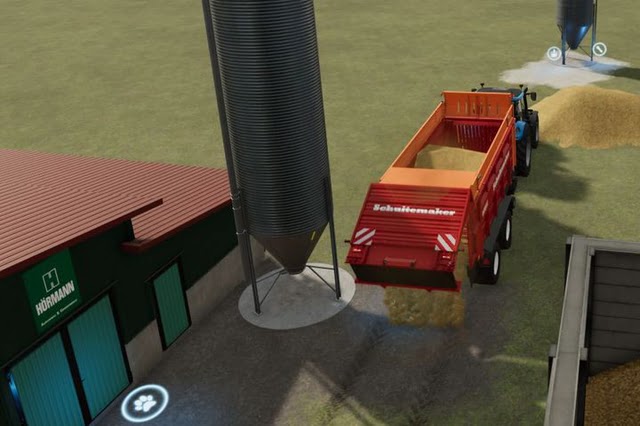
Straw is an optional ingredient for producing manure and does not affect the health of the animals. You need to drop it in the feeding area.
Reproduction
Pigs reach maturity at six months old. With full health and meeting all their needs (full-value feed, straw, and water), subsequent animals will be born after four months (increasing the reproduction rate by 25% per month). You can calculate how long you need to wait by feeding the animals with lower efficiency food. Each adult pig produces one offspring.
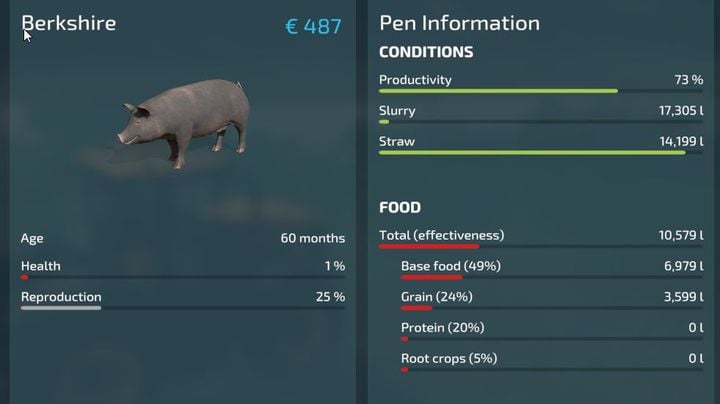
Reproduction will not start until the animal’s health bar is full, which only happens when all animal requirements (water and food) are met. The health bar fills up faster or slower depending on the effectiveness of the food. Straw is not necessary to improve health.
Slurry and Manure
Pigs produce slurry and, optionally, manure. To get manure, you need to build a special prism near the pigsty (approximately 30m away). Pastures do not produce manure or slurry. Manure requires straw, and without it, animals develop and multiply normally, but you will not get valuable fertilizer.
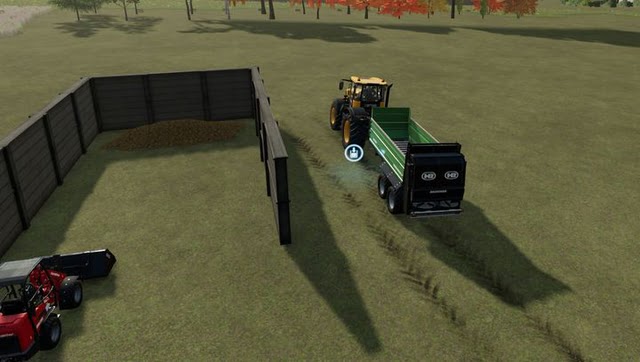
In FS22, you do not have to load manure manually. Stand next to the marker and load any trailer or spreader with it.
You can sell fertilizers at a biogas plant, even if you do not use them. Therefore, it is worth providing straw to pigs and collecting a pile of manure. Prices are shown in the menu.
If you have your biogas plant, both types of fertilizer supplied to it will convert into smaller amounts of digestate – a slurry substitute. This standardizes the fertilization process, helps with excess fertilizer, and generates extra cash (profit from the biogas plant).

You can pour digestate by using a vertical pipe coming out of the underground tank.
Profitability
Since most of the money comes from animals, it is worth using a trailer to transport them to a selling point to avoid additional costs. However, if you primarily raise pigs for fertilizer, you won’t have to transport large quantities of pigs as often.
Rounded values. Production and consumption calculated per month for ten animals.
|
Adult pigs (6th month) |
|
|
Purchase price |
525 EUR/piece The table shows monthly food and straw consumption, as well as monthly manure and slurry production. Breeding occurs every 4 months. The maximum value of the animals is 1,200 EUR at 24 months of age. FAQ1. How do I breed pigs in Farming Simulator 22? Breeding pigs in Farming Simulator 22 requires you to have a pigsty, which can be purchased from the store. Once you have a pigsty, you need to buy pigs from the store and place them in the pigsty. You will also need to provide them with food and water. To breed pigs, you will need to make sure that you have at least one male and one female pig in the pigsty. Once the pigs reach maturity, they will start breeding and producing piglets. 2. What are some tips for breeding pigs in Farming Simulator 22? To successfully breed pigs in Farming Simulator 22, it is important to keep their environment clean and maintain their health. Make sure to regularly clean the pigsty and provide them with fresh water and food. It is also important to keep an eye on their health and treat any illnesses or injuries promptly. Additionally, it is recommended to keep the male and female pigs separated until you are ready for them to breed to avoid any unexpected breeding. 3. How do I sell my pigs in Farming Simulator 22? To sell your pigs in Farming Simulator 22, you will need to load them onto a trailer and transport them to the selling point. The selling point can be found on the map and is usually located near the town or village. Once you arrive at the selling point, you can sell your pigs by unloading them from the trailer. 4. What are the benefits of breeding pigs in Farming Simulator 22? Breeding pigs in Farming Simulator 22 can be a profitable venture as you can sell the piglets or mature pigs for a good price. Additionally, pigs can be a source of manure, which can be used as fertilizer for crops. Breeding pigs can also add another layer of complexity to the game and provide a new challenge for players to master.  James, a young and enthusiastic gamer. With a passion for gaming, he personally plays and experiences the games he writes about, providing authentic and insightful content to fellow gamers. |
